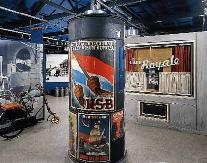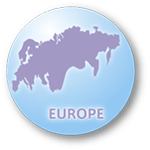EUROPE
Dutch Resistance Museum (The Netherlands)
(April 28, 2008)
by Marjolein Marreveld, PR and Publicity
From May 14, 1940 to May 5, 1945, the Netherlands was occupied by Nazi Germany. Almost every Dutch person was affected by the consequences of the occupation. The choices and dilemmas facing the population became more far-reaching.
The main purpose of the museum is to inform new generations about what happened in Holland during WWII in regard to the occupation and the resistance against this occupation: How did Dutch people respond to the increasing oppression of the occupying power? Who took up resistance? Why, and in what ways? The museum thus stresses the importance of liberty, freedom of speech, tolerance, and equality for all people.
The Plancius Building, in which the Dutch Resistance Museum is located, was built in 1876 as the social club for a Jewish choir. Inside the museum, the model streets and walls full of photos that make up the museum help evoke the climate of the war years.
The permanent exhibition highlights the stories of ordinary people in extraordinary situations, the daily life of people in Holland during the occupation, and the lives of those who resisted and those who did not.
The exhibition covers all forms of resistance: strikes, the forging of documents, helping people go into hiding, underground newspapers, escape routes, armed resistance, and espionage.
The authentic objects, documents, photos, films, and sound segments tell the history of the people who lived through that period. On display are such artifacts as the hiking boots worn by a young Jewish woman who escaped to England and the Christmas tree which Carel Steensma, arrested for resistance work, made with the cardboard used for blacking out the windows of Weteringschans Prison in Amsterdam.The main focus is on the difficult choices many had to face while told through gripping stories. Information regarding Holland’s former colony, the Dutch East Indies, where the population suffered under Japanese occupation, is also introduced.
In addition to the permanent exhibition, the museum hosts about five temporary exhibitions each year. The permanent exhibition and most temporary exhibitions provide information in both Dutch and English.
We also publish a booklet called “Persecution and Resistance in Amsterdam” which includes a map for an instructive walking tour from Anne Frank House to the Dutch Resistance Museum.
Address: Plantage Kerklaan 61, 1018 CX Amsterdam, The Netherlands
Tel: +31-(0)20-620-25-35
Homepage: http://www.dutchresistancemuseum.org
Days closed: January 1, April 30, December 25
Admission: € 6.50
Groups 10 or More, € 5.00 (reservation required)
(Originally published on April 21, 2008)
 The atmosphere of Holland under Nazi occupation is recreated inside the Dutch Resistance Museum. |  Education is a core mission of the museum and many groups of children visit each year. |
 Peace Museums of EUROPE
Peace Museums of EUROPE